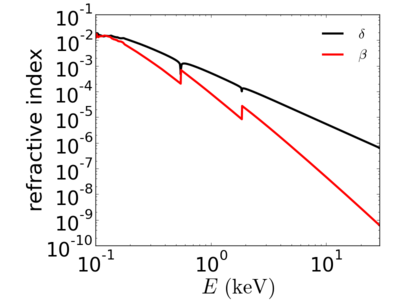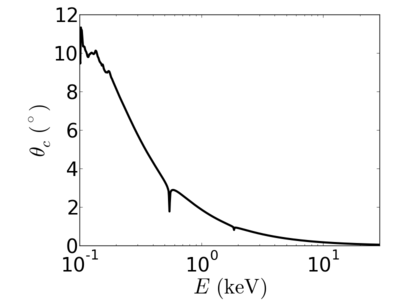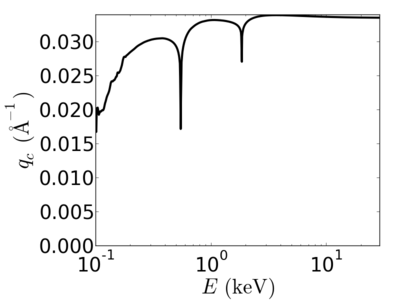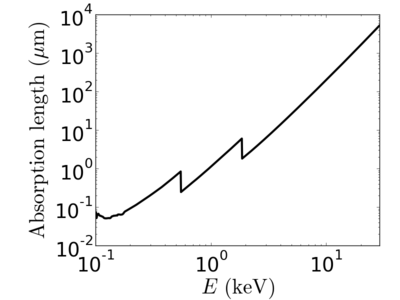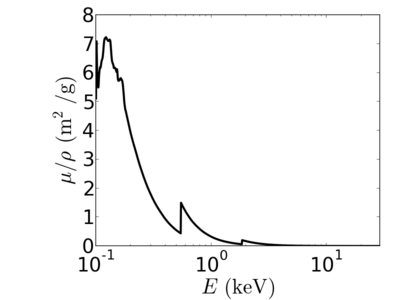Difference between revisions of "Material:Silicon dioxide"
KevinYager (talk | contribs) (Created page with "{| class="wikitable" |- ! Material ! density (g/cm<sup>3</sup>) ! X-ray energy (keV) ! X-ray wavelength (Å) ! critical angle (°) ! ''q<sub>c</sub>'' (Å<sup>−1</sup>) ! SL...") |
KevinYager (talk | contribs) (→Properties) |
||
| (5 intermediate revisions by 2 users not shown) | |||
| Line 1: | Line 1: | ||
| + | '''Silicon dioxide''' (SiO<sub>2</sub>), also known as silica, spontaneously forms on the surface of a [[Material:Silicon|silicon]] wafer exposed to air. This 'native oxide' must be included in calculations of (for example) the x-ray [[reflectivity]] curve for a Si surface. In terms of x-ray properties, SiO<sub>2</sub> can be used to approximate a variety of related materials (fused quartz, glass, etc.). | ||
| + | |||
| + | ==Properties== | ||
| + | * Density: 2.648 g/cm<sup>3</sup> | ||
| + | * Neutron [[SLD]]: 4.183×10<sup>−6</sup> Å<sup>−2</sup> | ||
| + | |||
| + | |||
| + | |||
{| class="wikitable" | {| class="wikitable" | ||
|- | |- | ||
| Line 10: | Line 18: | ||
|- | |- | ||
| [[Material:Silicon dioxide|SiO2]] | | [[Material:Silicon dioxide|SiO2]] | ||
| − | | | + | | 2.648 |
| 2.0 | | 2.0 | ||
| 6.20 | | 6.20 | ||
| − | | 0. | + | | 0.927 |
| − | | 0. | + | | 0.0328 |
| − | | | + | | 21.42 |
|- | |- | ||
| | | | ||
| Line 21: | Line 29: | ||
| 4.0 | | 4.0 | ||
| 3.10 | | 3.10 | ||
| − | | 0. | + | | 0.480 |
| − | | 0. | + | | 0.0340 |
| − | | | + | | 22.96 |
|- | |- | ||
| | | | ||
| Line 29: | Line 37: | ||
| 8.0 | | 8.0 | ||
| 1.55 | | 1.55 | ||
| − | | 0. | + | | 0.239 |
| − | | 0. | + | | 0.0338 |
| − | | | + | | 22.71 |
|- | |- | ||
| | | | ||
| Line 37: | Line 45: | ||
| 12.0 | | 12.0 | ||
| 1.03 | | 1.03 | ||
| − | | 0. | + | | 0.159 |
| − | | 0. | + | | 0.0337 |
| − | | | + | | 22.58 |
| + | |- | ||
| + | | | ||
| + | | | ||
| + | | 13.5 | ||
| + | | 0.92 | ||
| + | | 0.141 | ||
| + | | 0.0337 | ||
| + | | 22.56 | ||
|- | |- | ||
| | | | ||
| Line 45: | Line 61: | ||
| 16.0 | | 16.0 | ||
| 0.77 | | 0.77 | ||
| − | | 0. | + | | 0.119 |
| − | | 0. | + | | 0.0337 |
| − | | | + | | 22.53 |
|- | |- | ||
| | | | ||
| Line 53: | Line 69: | ||
| 24.0 | | 24.0 | ||
| 0.52 | | 0.52 | ||
| − | | 0. | + | | 0.079 |
| − | | 0. | + | | 0.0336 |
| − | | | + | | 22.48 |
|} | |} | ||
| + | |||
| + | [[Image:SiO2-n.png|400px]] | ||
| + | |||
| + | [[Image:SiO2-crit.png|400px]][[Image:SiO2-crit_zoom.png|400px]] | ||
| + | |||
| + | [[Image:SiO2-critq.png|400px]][[Image:SiO2-SLD.png|400px]] | ||
| + | |||
| + | [[Image:SiO2-AttLen.png|400px]][[Image:SiO2-mu.png|400px]] | ||
| + | |||
| + | ==See Also== | ||
| + | * [http://en.wikipedia.org/wiki/Silicon_dioxide Wikipedia: Silicon dioxide] | ||
Latest revision as of 08:36, 22 May 2018
Silicon dioxide (SiO2), also known as silica, spontaneously forms on the surface of a silicon wafer exposed to air. This 'native oxide' must be included in calculations of (for example) the x-ray reflectivity curve for a Si surface. In terms of x-ray properties, SiO2 can be used to approximate a variety of related materials (fused quartz, glass, etc.).
Properties
- Density: 2.648 g/cm3
- Neutron SLD: 4.183×10−6 Å−2
| Material | density (g/cm3) | X-ray energy (keV) | X-ray wavelength (Å) | critical angle (°) | qc (Å−1) | SLD (10−6Å−2) |
|---|---|---|---|---|---|---|
| SiO2 | 2.648 | 2.0 | 6.20 | 0.927 | 0.0328 | 21.42 |
| 4.0 | 3.10 | 0.480 | 0.0340 | 22.96 | ||
| 8.0 | 1.55 | 0.239 | 0.0338 | 22.71 | ||
| 12.0 | 1.03 | 0.159 | 0.0337 | 22.58 | ||
| 13.5 | 0.92 | 0.141 | 0.0337 | 22.56 | ||
| 16.0 | 0.77 | 0.119 | 0.0337 | 22.53 | ||
| 24.0 | 0.52 | 0.079 | 0.0336 | 22.48 |
